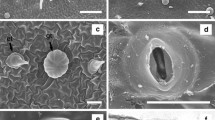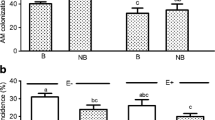Abstract
The effect of different genotypes of the ectomycorrhizal fungus Hebeloma cylindrosporum on in vitro rooting of micropropagated cuttings of Prunus avium and P. cerasus was studied in an attempt to determine whether ectomycorrhizal fungi could enhance in vitro adventitious root formation in plants which form arbuscular endomycorrhizas. The rooting percentage of P. avium cuttings was approximately 16% in the absence of hormonal treatment; it increased up to 30% in the presence of 5.7 μM IAA which was the most favourable auxin concentration. The rooting percentage of cuttings cultivated in the absence of IAA was enhanced by all the studied strains of H. cylindrosporum. It ranged from 50 to 60% with the IAA-overproducing mutant D 111 or the wild-type dikaryon D1, to 100% in the presence of the mutants 331 or D 117. The cuttings of P. cerasus showed a higher rooting ability than those of P. avium since approximately 40% of them were able to root in the absence of hormonal treatment. Except for the mutant D117, their rooting percentage was not significantly improved by H. cylindrosporum. Fungal inoculation also affected the survival of cuttings at acclimatization: 50% of the uninoculated P. avium cuttings survived whereas the survival percentage of inoculated cuttings ranged from 30 to 100% depending on the fungal genotype. With P. cerasus, the percentage of survival of uninoculated cuttings ranged from 85 to 100% and fungi either did not significantly improve it or lowered it. At acclimatization fungal hyphae could be observed in close contact with adventitious roots, but they did not establish mycorrhizal association. The shoot height of P. avium plantlets obtained from inoculated cuttings was not significantly different from that of plantlets originating from uninoculated ones. By contrast, fungal inoculation generally depressed the growth of acclimatized P. cerasus plantlets. The possibility of using ectomycorrhizal fungi as a tool to enhance rooting of micropropagated cuttings of plants which do not form ectomycorrhizas is discussed.
Similar content being viewed by others
Author information
Authors and Affiliations
Additional information
Received: 25 November 1996 / Accepted: 2 June 1997
Rights and permissions
About this article
Cite this article
Grange, O., Bärtschi, H. & Gay, G. Effect of the ectomycorrhizal fungus Hebeloma cylindrosporum on in vitro rooting of micropropagated cuttings of arbuscular mycorrhiza-forming Prunus avium and Prunus cerasus . Trees 12, 49–56 (1997). https://doi.org/10.1007/PL00009696
Issue Date:
DOI: https://doi.org/10.1007/PL00009696




